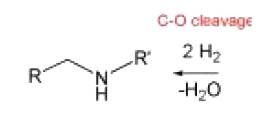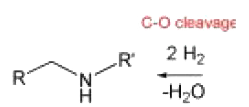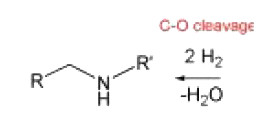What is correct about the following satement
(a) Portion of spectrum between 500-800 nm is PAR
(b) Mg, Ca, Cl have prominent role in photolysis of water
In cyclic photophosphorylation, O2 and NADPH are not produced
a true, b, c false
b true, a, c false
a, b true, c false
a, b false, c true
The correct Answer is:D
Step by step video, text & image solution for What is correct about the following satement (a) Portion of spectrum between 500-800 nm is PAR (b) Mg, Ca, Cl have prominent role in photolysis of water In cyclic photophosphorylation, O_(2) and NADPH are not produced by Biology experts to help you in doubts & scoring excellent marks in Class 12 exams.
Updated on:21/07/2023Topper's Solved these Questions
Similar Questions
Give the names and formula of the compounds indicated in the following statements.
(a). A compounds of Ca used in setting fractured bones.
(b). A compounds of calcium and hydrogen which is used as a prtable source of hydrogen for filling balloons.
(c ). A compounds of Ca,O,Cl and H used as germicide.
(d). A compound of Mg,O,Cl and H used as a cement for joining cracked teeth.
(e). A compound of Mg,Cl and O used as a drying agent. ltbRgt (f). A compound of Ca and O which when heated in oxycoal gas flame gives limelight.
(g). A compound of Ca,C and N used as a fertiliser.
(h). A triatomic compound of Ca which gives H2 on treatments with water.
View SolutionRead the following four statements, A, B, C and D and select the right option having both correct statements.
Statements :
(A) Z scheme of light reaction takes place in present of PSI only.
(B) Only PSI is functional in cyclic photophosphorylation
(C) Cyclic photophosphorylation results into synthesis of ATPandNADPH2
(D) Stroma lamellae lack PSII as well as NADP Options:
View Solution
Knowledge Check
Consider the following statements
(A) The portion of the spectrum between 500nm and 800 nm is also referred to as photosynthetically active radiation (PAR)
(B) Magnesium, calcium and chloride ions play prominet roles in the photolysis of water
(C) In cyclic photopphosphorylation, oxygen is not released (as there is no photolysis of water) and NADPH is also not producedAA is true, but B and C are falseBA and B are false, but C is trueCB is true, but A and and C are falseDA and B are true, but C is falseWhich of the following statement is / are incorrect ?
(i) Green light falling in the range of wavelength 500 0 -580 nm is least effective for photosynthesis.
(ii) In non - cyclic photophosphorylation, the electron expelled from the reaction centre is not cycled back , though its loos is compensated by electrons from the photolysis of water .
(iii) Chl a , Chl b , carotenoids , and xanthophylls are insoluble in organic solvents.
(iv) 400-700 nm light is used in photosynthesis also known as PAR.
(v) Red light is the most effective for photosynthesis.A(iv) and (v)B(iii) and (v)C(ii) and (v)D(iv) onlyRead the following four statement A,B,C and D and select the right opition having both correct statements.
statements
(a) Z scheme of light raction takes place in presence of PS I only .
(B ) Omly PS I is functional in cyclic photosporylation
(c ) Cyclic photophosphorylation results into synthesis of ATP and NADPH2
(D ) Stroma lamllae lack PSII as welll as NADPA(B ) and(D)B(A ) and (B )C(B) and(c )D(C ) and (D)
Read the passage given below and answer the question:
In the last 10 years much has been learned about the molecular structure of elemental sulfur. It is now known that many different types of rings are sufficiently metastable to exist at room temperature for several days. It is known that at high temperature, the equilibrium composition allows for a variety of rings and chains to exist in comparable concentration, and it is known that at the boiling point and above, the vapor as well as the liquid contains small species with three, four, and five atoms.
The sulfur atom has the same number of valence electrons as oxygen. Thus, sulfur atoms S2 and S3 have physical and chemical properties analogous to those of oxygen and ozone. S2 has a ground state of 38 σ3s2σ*3s2σ3pz2π3px2=π3py2π*3px1=π*3py1.S3 , thiozone has a well- known uv spectrum, and has a bent structure, analogous to its isovalent molecules O3,SO2, and S2O. The chemistry of the two elements, sulphur and oxygen, differs because sulfur has a pronounced tendency for catenation. The most frequently quoted explanation is based on the electron structure of the atom. Sulfur has low-lying unoccupied 3d orbitals, and it is widely believed that the 4s and 3d orbitals of sulfur participate in bonding in a manner similar to the participation of 2s and 2p orbitals in carbon.
(source: Meyer, B. (1976). Elemental sulfur. Chemical Reviews, 76(3), 367-388. doi:10.1021/cr603010003 )
In the following question, a statement of assertion followed by a statement of reason is given. Choose the correct answer out of the choices on the basis of the above passage.
Assertion: Thiozone has bent structure like ozone.
Reason: Ozone has a lone pair which makes the molecule bent.
View SolutionRead the passage given below and answer the following questions:
Reduction of carboxylic acids and their derivatives plays an important role in organic synthesis, in both laboratory and industrial processes. Traditionally, the reduction is performed using stochiometric amounts of hydride reagents, generating stochiometric amounts of waste. A much more attractive, atom-economical approach is a catalytic reaction using H2, however, hydrogenation of carboxylic acid derivatives under mild conditions is a very challenging task, with amides presenting the highest challenge among all classes of carbonyl compounds. Very few examples of the important hydrogenation of amides to amines, in which the C-O bond is cleaved with the liberation of water (Scheme 1), were reported. C-O cleavage of amides can also be affected with silanes as reducing agents.

We have now prepared the new, dearomatized, bipyridine-based pincer complex 3, catalyst 3(Here refered as Cat. 3). Remarkably, it efficiently catalyzes the selective hydrogenation of amides to form amines and alcohols (eq 1). The reaction proceeds under mild pressure and neutral conditions, with no additives being required. Since the reaction proceeds well under anhydrous conditions, hydrolytic cleavage of the amide is not involved in this process.

(Balaraman, E., Gnanaprakasam, B., Shimon, L. J., & Milstein, D. (2010). Direct hydrogenation of amides to alcohols and amines under mild conditions. Journal of the American Chemical Society, 132(47), 16756-16758.)
In the following questions, a statement of assertion followed by a statement of reason is given. Choose the correct answer out of the following choices on the basis of the above passage.
Assertion: Aniline can be prepared from suitable amide using catalyst 3
Reason: The use of catalyst 3 is limited to aliphatic amides only.
View SolutionRead the passage given below and answer the question:
In the last 10 years much has been learned about the molecular structure of elemental sulfur. It is now known that many different types of rings are sufficiently metastable to exist at room temperature for several days. It is known that at high temperature, the equilibrium composition allows for a variety of rings and chains to exist in comparable concentration, and it is known that at the boiling point and above, the vapor as well as the liquid contains small species with three, four, and five atoms.
The sulfur atom has the same number of valence electrons as oxygen. Thus, sulfur atoms S2 and S3 have physical and chemical properties analogous to those of oxygen and ozone. S2 has a ground state of 38 σ3s2σ*3s2σ3pz2π3px2=π3py2π*3px1=π*3py1.S3 , thiozone has a well- known uv spectrum, and has a bent structure, analogous to its isovalent molecules O3,SO2, and S2O. The chemistry of the two elements, sulphur and oxygen, differs because sulfur has a pronounced tendency for catenation. The most frequently quoted explanation is based on the electron structure of the atom. Sulfur has low-lying unoccupied 3d orbitals, and it is widely believed that the 4s and 3d orbitals of sulfur participate in bonding in a manner similar to the participation of 2s and 2p orbitals in carbon.
(source: Meyer, B. (1976). Elemental sulfur. Chemical Reviews, 76(3), 367-388. doi:10.1021/cr603010003 )
In the following question, a statement of assertion followed by a statement of reason is given. Choose the correct answer out of the choices on the basis of the above passage.
Assertion: Sulphur has a greater tendency for catenation than oxygen.
Reason: 3d and 4s orbitals of Sulphur have same energy.
View SolutionRead the passage given below and answer the following questions:
Reduction of carboxylic acids and their derivatives plays an important role in organic synthesis, in both laboratory and industrial processes. Traditionally, the reduction is performed using stochiometric amounts of hydride reagents, generating stochiometric amounts of waste. A much more attractive, atom-economical approach is a catalytic reaction using H2, however, hydrogenation of carboxylic acid derivatives under mild conditions is a very challenging task, with amides presenting the highest challenge among all classes of carbonyl compounds. Very few examples of the important hydrogenation of amides to amines, in which the C-O bond is cleaved with the liberation of water (Scheme 1), were reported. C-O cleavage of amides can also be affected with silanes as reducing agents.

We have now prepared the new, dearomatized, bipyridine-based pincer complex 3, catalyst 3(Here refered as Cat. 3). Remarkably, it efficiently catalyzes the selective hydrogenation of amides to form amines and alcohols (eq 1). The reaction proceeds under mild pressure and neutral conditions, with no additives being required. Since the reaction proceeds well under anhydrous conditions, hydrolytic cleavage of the amide is not involved in this process.

(Balaraman, E., Gnanaprakasam, B., Shimon, L. J., & Milstein, D. (2010). Direct hydrogenation of amides to alcohols and amines under mild conditions. Journal of the American Chemical Society, 132(47), 16756-16758.)
In the following questions, a statement of assertion followed by a statement of reason is given. Choose the correct answer out of the following choices on the basis of the above passage.
Assertion: Use of hydride catalyst or hydrogen brings about cleavage of C-O bond in amides.
Reason: Hydride catalyst or hydrogen cause to reduction of amides.
View SolutionRead the passage given below and answer the following questions:
Reduction of carboxylic acids and their derivatives plays an important role in organic synthesis, in both laboratory and industrial processes. Traditionally, the reduction is performed using stochiometric amounts of hydride reagents, generating stochiometric amounts of waste. A much more attractive, atom-economical approach is a catalytic reaction using H2, however, hydrogenation of carboxylic acid derivatives under mild conditions is a very challenging task, with amides presenting the highest challenge among all classes of carbonyl compounds. Very few examples of the important hydrogenation of amides to amines, in which the C-O bond is cleaved with the liberation of water (Scheme 1), were reported. C-O cleavage of amides can also be affected with silanes as reducing agents.

We have now prepared the new, dearomatized, bipyridine-based pincer complex 3, catalyst 3(Here refered as Cat. 3). Remarkably, it efficiently catalyzes the selective hydrogenation of amides to form amines and alcohols (eq 1). The reaction proceeds under mild pressure and neutral conditions, with no additives being required. Since the reaction proceeds well under anhydrous conditions, hydrolytic cleavage of the amide is not involved in this process.

(Balaraman, E., Gnanaprakasam, B., Shimon, L. J., & Milstein, D. (2010). Direct hydrogenation of amides to alcohols and amines under mild conditions. Journal of the American Chemical Society, 132(47), 16756-16758.)
In the following questions, a statement of assertion followed by a statement of reason is given. Choose the correct answer out of the following choices on the basis of the above passage.
Assertion: N-methyl ethanamide on reaction with catalyst 3 will yield ethanol and methanamine.
Reason: Use of Catalyst 3 brings about cleavage of C-N bond of amides
View Solution
